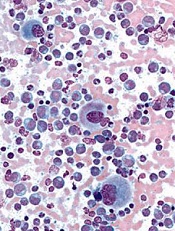User login

Credit: UCSD School of Medicine
By analyzing structural changes that occur during Abl kinase activation, researchers have gained new insight into this process.
The team discovered a mechanism that links the allosteric regulation of the SH2 domain to two critical phosphorylation events.
As allosteric SH2-kinase domain interactions have proven essential for leukemogenesis caused by Bcr-Abl, the researchers believe this finding has implications for treating chronic myeloid leukemia (CML).
Oliver Hantschel, PhD, of the École polytechnique fédérale de Lausanne (EPFL) in Lausanne, Switzerland, and his colleagues described this work in Nature Communications.
The team made small, strategic mutations to Abl kinase that caused its 3D structure to change. Then, they tested each mutant version of the enzyme to see if its function would change.
The researchers built on previous studies showing that Abl kinase is indirectly controlled by the SH2 region. Normally, the SH2 region regulates the activation loop by opening and closing it. But under the Philadelphia chromosome translocation, that regulation is lost.
The team discovered that when the Philadelphia mutation takes effect, the SH2 region changes the Abl activation loop to a fully open conformation. This enables the trans-autophosphorylation of the activation loop and requires prior phosphorylation of the SH2-kinase linker.
This discovery provides the first-ever picture of the molecular events surrounding the hyperactivity of Abl kinase, the researchers said.
They also found that by disrupting the SH2-kinase interaction, it’s possible to modulate the activity of Abl kinase, which could potentially stop the growth of leukemia.
Since the SH2 region is common to other kinases, the researchers think it’s likely the effect could extend to malignancies other than CML as well, particularly those characterized by abnormal kinase activity.
Finally, the team expects this approach could overcome the problem of drug resistance in CML, as it might offer an alternative way to inhibit Abl kinase, and mutations of rapidly growing cancer cells may be less likely to occur. ![]()

Credit: UCSD School of Medicine
By analyzing structural changes that occur during Abl kinase activation, researchers have gained new insight into this process.
The team discovered a mechanism that links the allosteric regulation of the SH2 domain to two critical phosphorylation events.
As allosteric SH2-kinase domain interactions have proven essential for leukemogenesis caused by Bcr-Abl, the researchers believe this finding has implications for treating chronic myeloid leukemia (CML).
Oliver Hantschel, PhD, of the École polytechnique fédérale de Lausanne (EPFL) in Lausanne, Switzerland, and his colleagues described this work in Nature Communications.
The team made small, strategic mutations to Abl kinase that caused its 3D structure to change. Then, they tested each mutant version of the enzyme to see if its function would change.
The researchers built on previous studies showing that Abl kinase is indirectly controlled by the SH2 region. Normally, the SH2 region regulates the activation loop by opening and closing it. But under the Philadelphia chromosome translocation, that regulation is lost.
The team discovered that when the Philadelphia mutation takes effect, the SH2 region changes the Abl activation loop to a fully open conformation. This enables the trans-autophosphorylation of the activation loop and requires prior phosphorylation of the SH2-kinase linker.
This discovery provides the first-ever picture of the molecular events surrounding the hyperactivity of Abl kinase, the researchers said.
They also found that by disrupting the SH2-kinase interaction, it’s possible to modulate the activity of Abl kinase, which could potentially stop the growth of leukemia.
Since the SH2 region is common to other kinases, the researchers think it’s likely the effect could extend to malignancies other than CML as well, particularly those characterized by abnormal kinase activity.
Finally, the team expects this approach could overcome the problem of drug resistance in CML, as it might offer an alternative way to inhibit Abl kinase, and mutations of rapidly growing cancer cells may be less likely to occur. ![]()

Credit: UCSD School of Medicine
By analyzing structural changes that occur during Abl kinase activation, researchers have gained new insight into this process.
The team discovered a mechanism that links the allosteric regulation of the SH2 domain to two critical phosphorylation events.
As allosteric SH2-kinase domain interactions have proven essential for leukemogenesis caused by Bcr-Abl, the researchers believe this finding has implications for treating chronic myeloid leukemia (CML).
Oliver Hantschel, PhD, of the École polytechnique fédérale de Lausanne (EPFL) in Lausanne, Switzerland, and his colleagues described this work in Nature Communications.
The team made small, strategic mutations to Abl kinase that caused its 3D structure to change. Then, they tested each mutant version of the enzyme to see if its function would change.
The researchers built on previous studies showing that Abl kinase is indirectly controlled by the SH2 region. Normally, the SH2 region regulates the activation loop by opening and closing it. But under the Philadelphia chromosome translocation, that regulation is lost.
The team discovered that when the Philadelphia mutation takes effect, the SH2 region changes the Abl activation loop to a fully open conformation. This enables the trans-autophosphorylation of the activation loop and requires prior phosphorylation of the SH2-kinase linker.
This discovery provides the first-ever picture of the molecular events surrounding the hyperactivity of Abl kinase, the researchers said.
They also found that by disrupting the SH2-kinase interaction, it’s possible to modulate the activity of Abl kinase, which could potentially stop the growth of leukemia.
Since the SH2 region is common to other kinases, the researchers think it’s likely the effect could extend to malignancies other than CML as well, particularly those characterized by abnormal kinase activity.
Finally, the team expects this approach could overcome the problem of drug resistance in CML, as it might offer an alternative way to inhibit Abl kinase, and mutations of rapidly growing cancer cells may be less likely to occur. ![]()